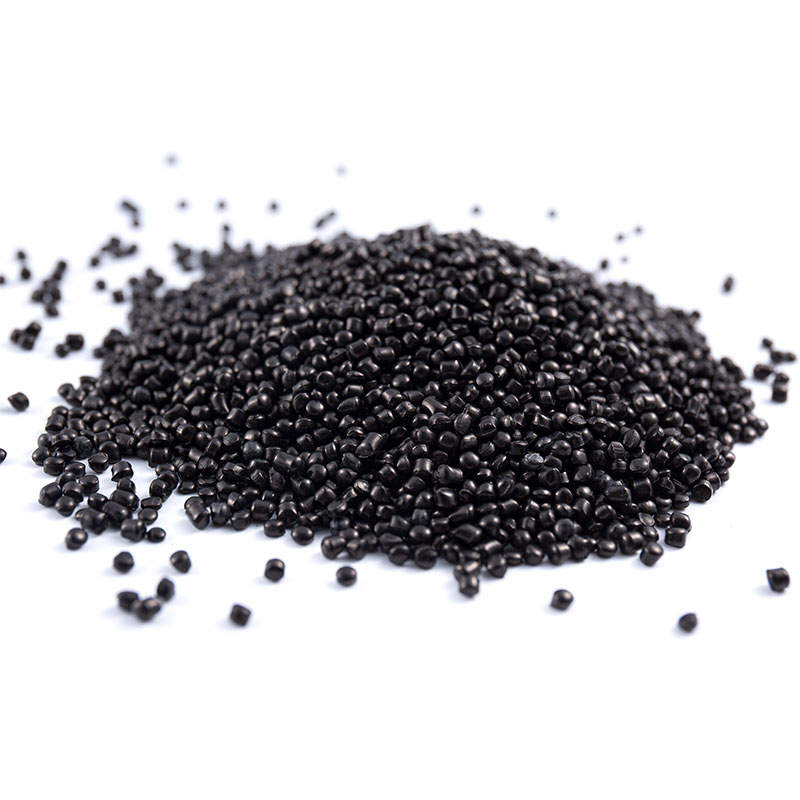The Main Advantages of Using Stretch Film Black Masterbatch
Stretch film black masterbatch plays a critical role in the production of packaging films, especially in enhancing the appearance, performance, and longevity of films. As a high-performance additive, stretch film black masterbatch primarily consists of carbon black, resin, and other functional additives, and is widely used in the packaging of food, industrial goods, and high-end consumer products. It offers significant advantages in improving the gloss, transparency, mechanical strength, and UV resistance of films.
First and foremost, stretch film black masterbatch significantly enhances the UV resistance of films. Carbon black, as the main light-absorbing agent, absorbs UV rays, preventing them from damaging packaged products and extending their shelf life. This is particularly important in food packaging, where prolonged exposure to sunlight can accelerate food spoilage. Through precise formulations and advanced dispersion technology, E-LUCK ensures that carbon black is evenly dispersed in the resin matrix, thereby guaranteeing the stability and durability of the films.
Secondly, stretch film black masterbatch plays a vital role in enhancing the mechanical properties of films. It increases the strength and toughness of the film, making it more resistant to tearing and puncturing, thus making it suitable for harsh transportation and storage environments. This is crucial for industrial packaging, where maintaining the integrity of products is of paramount importance.
In addition, stretch film black masterbatch improves the appearance of the film, enhancing both its gloss and transparency. While the addition of carbon black typically reduces the film's transparency, E-LUCK's black masterbatch optimizes the formulation to balance blackness with transparency, ensuring that the film has an attractive appearance while still offering light protection. This balance is particularly beneficial in high-end consumer product packaging, where both light protection and visual appeal are required.
How Stretch Film Black Masterbatch Differs from Regular Black Masterbatch
Stretch film black masterbatch differs from regular black masterbatch in terms of its application fields, formulation design, and performance optimization. Regular black masterbatch is typically used for colorant and light shielding in general plastic products, while stretch film black masterbatch is specifically optimized for the special performance requirements of film materials, particularly in areas such as UV resistance, mechanical strength, and transparency.
- Differences in Application Fields
Regular black masterbatch is primarily used for injection molding, extrusion, pipe manufacturing, and other industrial applications to improve the appearance, light shielding, and UV resistance of plastic products. In contrast, stretch film black masterbatch is specifically designed for use in film products, especially stretch films, where it better meets the unique requirements of film production and application, such as gloss, transparency, mechanical strength, and durability.
- Differences in Formulation Design
Regular black masterbatch is designed for basic color and light shielding functions and is suitable for most standard plastic products. Stretch film black masterbatch, however, is formulated with a more complex recipe, optimizing the ratio of resin and carbon black, while incorporating functional additives such as UV stabilizers, antioxidants, and other performance-enhancing agents. This makes the stretch film black masterbatch more suitable for film applications where UV resistance, aging resistance, and strength are essential.
- Differences in Performance Optimization
Stretch film black masterbatch places special emphasis on the film's processability and performance enhancement. As films typically require high stretchability and flexibility, stretch film black masterbatch is more finely tuned for dispersion and particle size control to ensure high processing efficiency and stability during film production without affecting the transparency of the film. Regular black masterbatch does not have the same stringent requirements for dispersion and particle size control as it is not used for film-specific applications.
How Stretch Film Black Masterbatch Affects Film Gloss and Transparency
The gloss and transparency of stretch films are two critical factors influencing the overall quality of packaging films, which in turn affect consumer perception and brand image. While carbon black in stretch film black masterbatch typically impacts film transparency, E-LUCK optimizes the formulation and employs advanced dispersion technology to ensure that gloss and transparency are balanced while maintaining the desired performance.
- Impact on Gloss
Gloss is the ability of the film surface to reflect light. Typically, the addition of carbon black reduces the film’s gloss because carbon black absorbs light and reduces reflection. E-LUCK’s stretch film black masterbatch uses unique dispersion technology to ensure that carbon black is evenly dispersed in the resin, minimizing the loss of gloss. By carefully controlling the amount of carbon black, E-LUCK’s black masterbatch can maintain a satisfactory gloss level for films, which is crucial in high-end packaging applications where aesthetic appeal is important.
- Impact on Transparency
Stretch films often require a high degree of transparency, particularly when the internal product or labels need to be visible. Although carbon black has strong light shielding properties, E-LUCK has formulated its stretch film black masterbatch to ensure that, while providing effective light shielding, the transparency of the film is not overly compromised. In particular, E-LUCK's formulation optimizes the film’s light-blocking ability without sacrificing transparency, ensuring that films meet the needs of various applications.
- Impact of Dispersion on Gloss and Transparency
The dispersion of the black masterbatch in the resin plays a significant role in determining both the gloss and transparency of the film. Poor dispersion of the masterbatch can lead to uneven gloss on the film surface and deteriorate transparency. E-LUCK utilizes advanced dispersion technology to ensure that every particle of the black masterbatch is evenly distributed within the resin. This results in a uniform gloss on the surface of the film and minimizes any loss of transparency, ensuring that the final product not only performs well but also maintains an attractive visual appearance.
What is the Production Process of Stretch Film Black Masterbatch?
The production process of stretch film black masterbatch involves several critical stages, including raw material selection, carbon black dispersion, melt extrusion, pelletizing, and quality control. Each step requires precise control and technological expertise to ensure the final product’s quality and performance meet customer requirements. As a professional manufacturer, E-LUCK employs advanced production techniques to provide high-quality, stable stretch film black masterbatch solutions to clients.
- Raw Material Selection and Preparation
The primary raw materials for stretch film black masterbatch are carbon black and resin. Based on customer requirements, E-LUCK selects different types of resins (such as polyethylene, polypropylene, etc.) and high-quality carbon black to ensure the quality, dispersion, and performance of the masterbatch. In addition, functional additives such as UV stabilizers and antioxidants are added to improve the aging resistance and stability of the film.
- Dispersion and Mixing of Carbon Black
The dispersion of carbon black is a crucial step in the production of stretch film black masterbatch. Due to the fine particle size and strong oil affinity of carbon black, it can be difficult to achieve uniform dispersion in the resin, which can negatively affect the quality of the masterbatch. E-LUCK uses advanced twin-screw extruders and high-shear mixers to ensure that carbon black is evenly distributed within the resin. This process guarantees the uniform color, physical properties, and gloss of the masterbatch.
- Melt Extrusion and Pelletizing
Once the mixture is evenly blended, it is fed into an extruder, where it is heated to the appropriate temperature for melt extrusion. After extrusion, the mixture is cooled and solidified, then passed through a pelletizer. The resulting pellets are uniform in size and shape, making them easy to handle and transport for subsequent processing.
- Quality Control and Testing
Every batch of stretch film black masterbatch undergoes rigorous quality control to ensure it meets customer specifications and industry standards. E-LUCK tests key attributes such as particle size distribution, dispersion quality, blackness, heat stability, and aging resistance. This ensures that the product performs well during film production and that the films maintain their quality over time.
- Packaging and Shipping
Once the masterbatch passes quality control, it is packaged in eco-friendly materials to protect it from contamination during transportation. Each batch of masterbatch is labeled with production information, including batch number and production date, to ensure traceability and easy inventory management.

 English
English Español
Español










